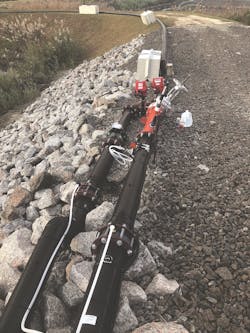Continuous Real-Time TSS & Effluent Quality
Dave Fraley is regional sales manager of Southeastern U.S. for Xylem Analytics. Chris Bauman is controls design engineer for Xylem Dewatering Solutions. Dave Donahue conducts outside sales for Xylem Dewatering. Fraley can be reached at [email protected], Donahue can be reached at [email protected], and Bauman can be reached at [email protected].
undefinedReducing the cost and compliance burden associated with meeting final coal ash remediation effluent requirements is a key driver for technical innovation. While many power plants continue to struggle with the critical last step in their coal ash remediation processes—the final testing phase—some plants have successfully adopted the use of recently advanced sensor technology to measure real-time total suspended solids (TSS) to verify their discharge water is meeting specified requirements.
TSS is the major parameter for verifying effluent quality in regulatory discharge permits for coal ash remediation. The necessity to consistently meet TSS discharge limits and avoid fines and other potential liabilities requires substantial field data collection, verification, documenting and reporting.
Significant Lag Results in Risk
Today, most coal combustion residuals (CCR) operations either retain or release plant effluent based on laboratory TSS test results that require at least a day to complete but frequently take at least two to three days or more. The existing TSS testing method for compliance verification is a time-consuming laboratory test that cannot be completed in the field unless by mobile certified field labs. This inherent lag-time between sampling and verification brings unknowns to the remediation process, often necessitating more field sampling and testing (erring on the side of over-compliance) than a plant’s permit requires. It also raises the potential for risky bottlenecks in overall remediation operations.
As part of their permit specifications, most plants have maximum allowable discharge flow rates, meaning only a certain number of gallons can be discharged in any 24-hour period. The permitted discharge volume depends primarily upon the regulatory designation of the receiving stream and the characteristics of the plant’s wastewater effluent. Once a plant has met its allowable discharge for the day, pumps must be turned off until the next day.
These discharge permits typically contain both a daily limit and a monthly limit for TSS, and most remediation operations have established their own internal limit, or daily high, that is set far enough below the regulatory permit limit to provide a margin of protection against violations.
Many facilities have turned to this expensive and burdensome over-compliance strategy because of the significant lag-time between gathering field samples and final laboratory TSS analysis. For example, a lab result from a sample pulled two days earlier shows TSS levels above the facility’s internally established limit or its permit limit. At this point, operations will stop discharging for an extended period of time to compensate. Because TSS monthly regulatory reporting is based on a time-weighted average, the plant receives a zero score for TSS discharge reporting for those days when pumps are off, thereby averaging out daily TSS levels to meet the monthly permit requirement.
Excessive zero days can lead to high-containment levels that can further exacerbate the potential for serious issues such as a pond breach during hurricanes and other severe weather events. Additionally, when the facility needs to discharge its effluent but cannot, the retaining basin or pond fills up with more water that must be pumped. Due to its daily maximum allowable discharge limit, a plant cannot get those zero days back by increasing the pump schedule other days to make up the difference. It is a vicious cycle.
Depending upon the permits, some locations test TSS levels several times per day. Other locations test several times a week. In either case, testing requires manpower to pull samples. Additionally, the facility must rely on an outside laboratory or perform the test in-house, which requires having a certified lab. To shave off some lag time, some facilities contract mobile certified labs to remain on-site full-time to handle effluent testing. Regardless of how lab tests are run, it is an expensive and labor-intensive process.
Probe-Based, Real-Time TSS Measurement
To reduce these high costs and compliance risks, some coal-fired power plants have successfully adopted advanced sensor technology to measure real-time TSS to verify their discharge water is meeting specified requirements.
TSS is a physical laboratory measurement; it defines the actual weight of suspended material in a given volume of water. The measurement derived from the optical sensor is not an absolute unit. However, TSS has a linear relationship with the scattering and backscattering coefficients of light. Light-scattering technology differentiates samples based on refractive index, size, shape and composition. Backscattering is a method of light-scattering measurement that correlates with TSS. The field probe reads the light measurements as a suspended solids value based on the calibration against laboratory grab sample analysis.
Real-time, probe-based TSS monitoring eliminates the need for frequent extra sampling and laboratory testing. Through rapid and consistent in-the-field TSS monitoring, these facilities reduce compliance risks and costs and consistently prevent costly project delays resulting from lengthy lab analysis procedures.
